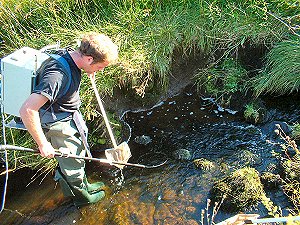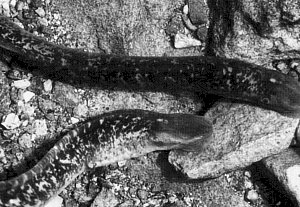Introduction
| Welcome to the latest newsletter from the Ayrshire Rivers Trust. 2003 saw a very busy field season, with the temporary employment of 2 additional biologists, Anthony Sykes and James Shannon, to help with the workload. The field season was taken up with an expanded fish monitoring programme on the Ayr, Doon, Girvan and Stinchar. Surveys of the Irvine and Garnock rivers were also carried out for the first time. The Trust has also surveyed habitat on the Stinchar and Irvine, and restored parts of the River Doon. Last year’s survey work is now being analysed and written up, and will be described in more detail in the ART annual report, which will come out later in the Spring.
As we move into 2004. the Trust has also been working on a strategic plan, setting out our aims, objectives and priorities for the next 5 years. The plan is currently in its final stages, and following a consultation period, will be available on request in the spring. Once this is completed, it will form the basis of a detailed action plan, describing the projects and targets which will be needed to achieve the Trust’s medium and long-term aims. The Trust has settled well into new office accommodation at Auchincruive, which allowing us to strengthen existing ties with conservation and agricultural organisations such as SAC and FWAG. With farming being one of the most important influences on our local rivers, these links are promoting our work to a crucial audience, and allowing us to learn more about the increasingly positive environmental work which is being carried out by farming groups. |
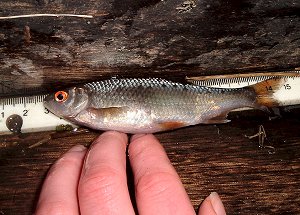 Fish monitoring programme
|
New work highlights the dangers of introducing farmed fish to our rivers
A recent Irish study examining the effects of interbreeding between escaped farmed salmon and wild populations has caused a great deal of interest among scientific and angling circles, as it has important implications not only for rivers affected by escaped farm salmon, but also for trout stocking practices. The study, led by Dr Phil McGinnity of the Irish Central Fisheries Board, and Professor Andy Ferguson of Queen’s University, Belfast, clearly showed that, when farmed fish are introduced to a wild population, and interbreed with wild fish, the resultant offspring are far less well adapted to the wild environment, and fewer individuals will survive to adulthood.
The figures in the study show that in the most extreme cases, this effect could be serious enough to cause extinction of the local stock, even in pristine rivers which are not otherwise affected by detrimental factors such as pollution, environmental degradation or poaching. Even where extinction does not occur, production of wild stocks can be seriously affected, resulting in fewer returning fish each year, and putting further pressure on our wild fish.
| The authors of the study point out that this effect is not confined to salmon. In fact, although escapes of farmed trout are quite rare, it is common practice for anglers to deliberately release a great number of farmed trout into our waters, effectively paying for the privilege of introducing farmed fish into the wild. These trout can, and do, interbreed with both wild brown trout and seatrout, and along with habitat degradation and poor survival at sea, this may be another important factor behind the crash of our local sea trout stocks.
Stocking with farmed trout definitely has its place, and the enclosed put-and-take stillwater fisheries in Ayrshire provide excellent-sport for many anglers, without harming wild fish stocks. |
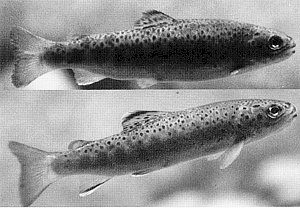 Wild trout (bottom) and farmed trout (top). Note the difference in body shape, patterning and fin size. Photo – J. Deverill |
However, in light of the Irish study, stocking wild rivers with farmed trout is likely to be detrimental over the long term, and ART recommends that all our readers consider carefully the potential damage that farmed trout can do to wild stocks. We suggest that less harmful alternatives such as setting up farmed strains from local broodstock, or stocking with sterile triploid trout are considered instead.
The full scientific paper, entitled “Fitness reduction and potential extinction of wild populations of Atlantic salmon Salmo salar as a result of interactions with escaped farmed salmon” is available from the biologist on request.
Devastating Salmon Disease Spreading Through Europe
The Scottish Executive has recently issued new warnings about the dangers of the Gyrodactylus salaris parasite. This small parasite infects the skin, gills and fins of salmonids and other freshwater fish, and can cause serious damage in some salmon strains. It occurs naturally in the Baltic Sea rivers, where fish, including salmon, have developed a natural resistance to the parasite.
Some years ago, Gyrodactylus was accidentally transferred from the Baltic to Sweden, Norway, and, more recently the northern rivers of Russia and Finland, where native fish have little or no tolerance to infection. Since then, the effects of the disease have been so serious that it has completely wiped out salmon stocks from some 20 Norwegian rivers.
Gyrodactylus has never been found in Britain or Ireland, but tests have shown that our salmon, like those of Norway, are killed by the parasite. If the disease does appear in any British river, eradication will only be possible by poisoning the entire catchment, to remove all fish capable of harbouring the disease. Even this may not always be successful.
The parasite is extremely hardy and can be inadvertently introduced by fishermen, as it is capable of surviving for several days in damp conditions such as wet angling equipment, or plastic bags. The life cycle of the parasite is such that even a single specimen can cause an epidemic. It is therefore absolutely essential that every effort is made to keep our rivers free of infection. Any anglers travelling from abroad, and especially from areas known to be infected (which now includes most of Europe) must ensure that they take adequate steps to disinfect their equipment. The Trust also recommends that all fishery owners ensure that anyone visiting their fishery is aware of these regulations, and has taken all necessary precautions.
All fishing equipment should be thoroughly cleaned, and disinfected by either:
- Drying at a minimum of 20°C for at least 48 hours.
- Heating for at least one hour at temperatures above 60°C.
- Deep freezing for at least 24 hours.
- Immersion in a suitable solution for at least 10 minutes. Chemicals which can be used include Vircon(1%), Wescodyne (1%), sodium chloride (3%) or sodium hydroxide (0.2%).
Posters and leaflets are available from the Trust biologist on request, to help publicise this advice.
Lampreys; Have you seen this fish?
| ART was contracted to carry out a survey of lamprey populations in Ayrshire as part of a national survey commissioned by Scottish Natural Heritage.
There are three species of this primitive eel-like fish in Scotland – sea, river and brook lampreys. All three species live in muddy riverbeds during their juvenile stage, which lasts for approximately 6 years. They change into adults in the autumn, when sea and river lampreys migrate downstream to estuaries and the open sea to feed as parasites on larger fish species. Brook lampreys do not feed as adults, and survive until spawning on reserves stored up during the juvenile stage. Relatively little is known about the distribution and abundance of the three species in Scotland, although the sea and river lampreys are now endangered, and are protected by conservation legislation. The ART survey examined the distribution of juvenile lamprey in the Irvine, Doon and Girvan by using a specially designed electrofishing method. No sea lampreys were found during the survey, suggesting that this species is particularly rare, but river and brook lampreys were more abundant, wherever the habitat was suitable. |
 Lamprey juveniles caught during the electrofishing survey
|
The results from the study are being collated with data from elsewhere in Scotland by Ecological Research Associates Ltd, and a full report will be available later in the year.
In the meantime, the national survey is keen to collect as many records as possible of lampreys in Scotland. If you have seen any lampreys in Ayrshire’s rivers over the past few years, you can help with the survey by passing details of the time and place, and a description of the lampreys, to the ART biologist. All of the data will be put into a central database, to give a detailed picture of the distribution of the three species in Scotland.
North American Signal Crayfish
| Many members may have seen recent newspaper reports about the spread of the North American signal crayfish in other parts of south-west Scotland. This foreign species was introduced into private ponds in the Upper Clyde and in parts of the Galloway Dee catchment, and has spread extremely quickly, with damaging results. Fortunately, it has not been found in any other Ayrshire rivers…….yet. We need your help to ensure that our rivers remain free from this invasive species, as once established, it is almost impossible to eradicate and difficult to control. | 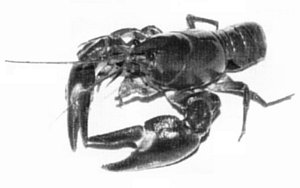 |
As with many introduced species, the crayfish has a lack of natural population controls, and where it is introduced populations expand extremely rapidly. The Galloway Fisheries Trust and the Clyde River Foundation have found that the crayfish quickly have a major impact on local invertebrate populations in affected areas, as it is a voracious predator. Crayfish can also prey on the eggs and young of some fish species, and directly compete with salmon and trout juveniles for food and shelter.
The most likely way for the species to spread is through deliberate introductions, usually into private ponds. However, it is an offence to be in possession of a live North American signal crayfish without a license. We would urge all our members to broadcast this information, and the problems the species can cause, as widely as possible.
To maximise the effectiveness of any control measures, it is also crucial that any sightings are reported as quickly as possible, and we would also ask members to be vigilant in checking for the species, and immediately inform
the biologist of any sightings.
Trust events
Fisherman’s Supper 2003
| The Trust’s 2003 supper in October was a great success, with over 100 people enjoying a night of food, song and laughter. We are once again greatly indebted to our star speaker Paul Young, who fascinated the audience with tales on angling far and wide, and helped the night to be such a success. Special thanks must also go to our other entertainers: Jack Glennie, David Fulton, Ricky Walker and Peter Gilmore and especially our compere for the evening Eddie Telford. Thanks to everyone who came along, we hope you enjoyed the evening as much as we did, and we hope to see you at next year’s event! |  Paul Young in conversation with the Trust Biologist and Freddy Taylor at the fisherman’s supper |
Christmas Raffle
Thanks to your support, the 2003 Christmas Raffle was a huge success, raising vital money to help with core funding for the Trust. A total of 23 Raffle prizes were drawn by local MSP Cathy Jamieson before Christmas, with notable local winners including Max Geller, who won the ART members prize of a try on the BAE systems flight simulator at Prestwick; JD Wylie of Pinmore, who won a Christmas Hamper, and Douglas McKenzie of East Kilbride, who won £100. A full list of winners is available on request.
New Lottery
The Trust has recently initiated a new fundraising initiative – from March 2004, we are selling tickets for a new monthly lottery. Subscriptions are £5, which covers 5 draws between March and July. Three cash prizes will be drawn each month, with winners being notified by post. If you would like to take part, please apply to the trust administrator before 15th March, enclosing a cheque for £5 made payable to Ayrshire Rivers Trust.
Dates for your diary
The trust is holding several fundraising events over the coming months. We hope that these will be fun and informative, as well as raising much needed funds to allow the trust to continue working on our local rivers.
Sunday 30th May 2004
Country Fair at Barskimming (by kind permission of the Hon Miss Jean Galbraith)
Friday 18th June 2004
Annual Auction Dinner at Blairquhan (by kind permission of James Hunter Blair)
Friday 22nd October 2004
Annual Fisherman’s Supper at the Cariston Hotel, Miller Road, Ayr
The Trust will also have an information stall at the Ayr Show on the 7th-9th May, and the Biodiversity Fair at Rozelle Estate on Saturday the 26th June 2004.
